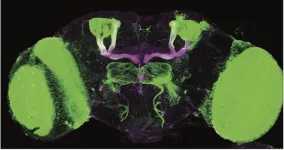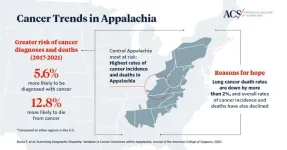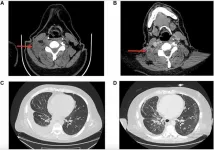(Press-News.org) A clinical trial comparing a one-page medication handout proposed by the U.S. Food and Drug Administration (FDA) with an updated version developed by researchers at the University of Pittsburgh that quantifies a drug’s risk and benefits showed that the latter was more informative and helped patients feel better equipped to make decisions.
Published today in JAMA Network Open, the study, which used the drug mifepristone as an example, highlights the importance of communicating risks and benefits of prescription medications – and the size of those risks and benefits.
“The FDA’s proposed patient medication information handout gets a lot of things right: it’s succinct and it’s simple,” said lead author Tamar Krishnamurti, Ph.D., associate professor in the Division of General Internal Medicine at the Pitt School of Medicine and Magee-Womens Research Institute. “But it’s missing nuances about risks and assumes that a patient already knows a drug’s benefits. Our study shows that this complexity can be explained in an easy-to-understand way, which can support people in making more informed decisions about their health.”
Currently, patient medication guides are provided under certain circumstances such as for drugs with serious risks or where product information could prevent serious adverse effects. But because these handouts do not have a standardized format, they can be lengthy — often four or five pages long — and unclear.
To help patients use medications more safely and effectively, the FDA recently proposed a new patient medication information (PMI) one-page handout for all prescription drugs used in an outpatient setting that clearly lays out directions for use, safety information, warnings and common side effects.
But there are no requirements to list the benefits of the medication, to quantify how effective it is or how often common side effects occur, or to explain how the medication works.
“The FDA may be assuming that when patients pick up their drugs, the benefits of the medication will have already been clearly communicated to them by their provider, but if someone is relying on a PMI to help them make a decision, this information should be included,” said Krishnamurti. “It’s also important to tell people about the size of risks and benefits of a medication, so that they know how likely something is to occur, not just that it’s possible.”
According to Krishnamurti, PMIs should also include a mechanistic explanation of how the drug works so that patients can understand what is happening in their body.
Focusing on mifepristone — which is used in combination with another drug called misoprostol to end pregnancies that are less than 10 weeks along — Krishnamurti and her team developed a so-called Decision Critical PMI that is similar to the FDA’s PMI but explains how the drug works, how often it is effective and how often side effects occur. For example, instead of stating that fever and headache are common side effects, it specifies that 48% of patients experience fever and 43% experience headache.
To test the effectiveness of different communications about mifepristone, the researchers recruited 330 female participants via an online survey. After being randomly assigned to view the drug vendor’s five-page medication guide, the FDA’s PMI or the Decision Critical PMI, participants were tested on their knowledge about the drug and answered questions about the usefulness of the information.
Participants rated both the FDA and Decision Critical PMIs as having higher readability compared with the vendor’s handout. The Decision Critical PMI scored better than the other two communications in terms of comprehension, supporting decision making and drug use directions.
“Our findings support other evidence that being transparent about uncertainty and giving people the numbers to evaluate the strength of evidence about a medication themselves is best practice for risk communication,” said Krishnamurti. “Our hope is that these findings inform changes to the FDA’s final requirements for the proposed PMI, which could be an incredibly useful communication for patients, particularly for drugs that may be subject to popular misinformation.”
According to Krishnamurti, the FDA’s proposal does not currently require pharmaceutical companies to test the messaging in their PMIs.
“The proposed regulation will tell vendors what topics they need to cover in the PMI, but there is no requirement for testing for how well people read or understand the materials,” she explained. “User testing should be a requirement for public-facing information on all drugs.”
Other authors on the study were Gianna White, M.S., Barry Dewitt, Ph.D., and Baruch Fischhoff, Ph.D., all of Carnegie Mellon University; and Elizabeth Mosley, Ph.D., M.P.H., of Pitt.
END
Updated drug information handout outdoes FDA’s version
2025-02-06
ELSE PRESS RELEASES FROM THIS DATE:
Gemini North teams up with LOFAR to reveal largest radio jet ever seen in the early universe
2025-02-06
From decades of astronomical observations scientists know that most galaxies contain massive black holes at their centers. The gas and dust falling into these black holes liberates an enormous amount of energy as a result of friction, forming luminous galactic cores, called quasars, that expel jets of energetic matter. These jets can be detected with radio telescopes up to large distances. In our local Universe these radio jets are not uncommon, with a small fraction being found in nearby galaxies, but they have remained elusive in the distant, early Universe until now.
Using a combination of telescopes, astronomers have discovered a distant, two-lobed radio ...
Researchers discover a major driver of inflammatory pathology in autoimmune and chronic inflammatory diseases
2025-02-06
Our immune system is armed with an array of defenses designed to detect and eliminate harmful threats. One of its most powerful defense mechanisms is the complement system—a group of proteins that patrols our body, ever vigilant for signs of infection or injury. Now, over 100 years after the complement system was first described, researchers at Mass General Brigham have discovered that a protein known as granzyme K (GZMK) drives tissue damage and inflammation by activating the complement system against our own tissues. Their findings not only reshape the century-old understanding of the complement system but also open new avenues for therapies that could specifically ...
Research in fruit flies pinpoints brain pathways involved in alcohol-induced insomnia
2025-02-06
Alcohol use disorder, which affects over 10% of Americans, can lead to persistent and serious insomnia. Difficulties falling asleep and staying asleep can last even after months of sobriety, increasing the risk of relapse. But treating withdrawal-related insomnia is difficult, partly because what’s going on in the brain in this condition remains largely mysterious.
Now, research in fruit flies has identified specific brain signals and groups of brain cells that are involved in alcohol-induced insomnia. This work could ultimately lead ...
Cancer diagnoses and deaths are declining in Appalachia but remain significantly higher compared to other US regions
2025-02-06
Key Takeaways:
Appalachia is not uniform: There are important distinctions in cancer diagnoses and deaths among different regions of Appalachia, with certain areas of Central Appalachia experiencing the highest rates of cancer incidence and deaths among the greater Appalachian region.
Higher death rates from cancers that can be caught early with screening: Although the region has improved in screening rates, people in Appalachia still die more frequently from cancers that can be caught early with routine screening than elsewhere in the United States.
Reason for hope: Research can pave the way for targeted interventions that can reduce these ...
Why some heavy drinkers develop advanced liver disease, while others do not
2025-02-06
LOS ANGELES — Why do some people who consume a few glasses of alcohol a day develop advanced liver disease while others who drink the same amount don’t?
The answer may lie in three common underlying medical conditions, according to a new study published in Clinical Gastroenterology and Hepatology from Keck Medicine of USC. The research found that heavy drinkers with either diabetes, high blood pressure or a high waist circumference are as much as 2.4 times more likely to develop advanced liver disease.
“The results ...
OmicsFootPrint: Mayo Clinic’s AI tool offers a new way to visualize disease
2025-02-06
ROCHESTER, Minnesota — Mayo Clinic researchers have pioneered an artificial intelligence (AI) tool, called OmicsFootPrint, that helps convert vast amounts of complex biological data into two-dimensional circular images. The details of the tool are published in a study in Nucleic Acids Research.
Omics is the study of genes, proteins and other molecular data to help uncover how the body functions and how diseases develop. By mapping this data, the OmicsFootPrint may provide clinicians and researchers with a new way to visualize ...
New genetic mutation linked to drug resistance in non-small cell lung cancer patient
2025-02-06
“Here we present a case of a patient with stage IV CD-74-ROS1 fusion NSCLC discovered initially with RNA next generation sequencing (NGS) who acquired resistance to lorlatinib after 6 months on therapy through a novel RUFY1-RET fusion, detected only through RNA NGS.”
BUFFALO, NY - February 6, 2025 – A new case report was published in Volume 16 of Oncotarget on February 5, 2025, titled “Acquired RUFY1-RET rearrangement as a mechanism of resistance to lorlatinib in a patient with CD74-ROS1 rearranged non-small cell lung cancer: A case report."
In this case report, Jenny L. ...
Single-photon LiDAR delivers detailed 3D images at distances up to 1 kilometer
2025-02-06
WASHINGTON — Researchers have designed a single-photon time-of-flight LiDAR system that can acquire a high-resolution 3D image of an object or scene up to 1 kilometer away. The new system could help enhance security, monitoring, and remote sensing by enabling detailed imaging even in challenging environmental conditions or when objects are obscured by foliage or camouflage netting.
“Our system uses a single-photon detector approximately twice as efficient as detectors deployed in similar LiDAR systems ...
Fear of breast cancer recurrence: Impact and coping with being in a dark place
2025-02-06
INDIANAPOLIS – Breast cancer is the world’s most prevalent cancer. Although earlier detection and targeted treatment have resulted in high survival rates, many breast cancer survivors experience fear of cancer recurrence. For some survivors this fear is occasional, for others it is persistent and often debilitating.
A new study of breast cancer survivors has found this psychosocial challenge impacts almost every important domain of their lives – the emotional, behavioral, cognitive, relational and professional. A larger number of domains was affected, ...
Korea University researchers analysis of income-related disparities in mortality among young adults with diabetes
2025-02-06
Korea University Researchers Analysis of Income-Related Disparities in Mortality Among Young Adults with Diabetes
Type 2 diabetics (T2D) under 40 years of age with low income have a threefold higher risk of mortality
Young people with T2D are more affected by income than elderly people with T2D
The research team of Professor Sin Gon Kim and Professor Nam Hoon Kim of department of internal medicine (Endocrinology and Metabolism) of Korea University Anam Hospital, and Professor Ji Yoon Kim of Samsung Medical Center confirmed that young adults with T2D with low income have 3 times higher mortality ...






